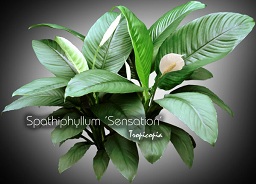Table of contents
Peace lily

Latin Name: Spathiphyllum ‘Sensation’
Category: Spathiphyllum
Family: Araceae
Origin: Cultivar
Climate: Tropical
Growing Zones: 11-10
Care Instructions
The Peace lily (Spathiphyllum ‘Sensation’) is a tropical plant that originates from Cultivar. This spathiphyllum plant belongs to the Araceae family and is well-suited for growing in USDA zones 11-10.
Complete Care Guide for Peace Lily (Spathiphyllum ‘Sensation’)
Watering Requirements
The Peace Lily is a relatively low-maintenance plant when it comes to watering. It thrives in consistently moist soil but is sensitive to overwatering. To ensure optimal health, water your Peace Lily when the top inch of soil feels dry to the touch. Typically, this means watering once a week, but frequency may vary based on environmental conditions such as humidity and temperature. During the growing season (spring and summer), you may need to increase watering slightly, while in the dormant months (fall and winter), reduce the frequency. Always use room temperature water and ensure that excess water can drain freely from the pot to prevent root rot.
Light Conditions
Peace Lilies prefer bright, indirect light but can also tolerate low-light conditions, making them ideal for indoor environments. Direct sunlight can scorch their leaves, leading to brown tips and edges. For optimal growth, place your Peace Lily near a window with filtered light or in a well-lit room. If you notice that your plant is not blooming, it may be a sign that it needs more light. However, be cautious not to expose it to harsh, direct sunlight, as this can cause damage. If you notice the leaves turning yellow, it may indicate that the plant is receiving too much light.
Soil Preferences
The ideal soil for a Peace Lily is a well-draining potting mix that retains moisture without becoming waterlogged. A mixture of peat moss, perlite, and pine bark works well, providing the necessary aeration and drainage. It’s important to repot your Peace Lily every couple of years to refresh the soil and provide more space for growth. When fertilizing, use a balanced, water-soluble fertilizer diluted to half strength every 6-8 weeks during the growing season. Avoid fertilizing in the fall and winter when the plant is dormant, as this can lead to fertilizer burn and damage the roots.
Pests and Diseases
Peace Lilies are generally resilient but can be susceptible to pests such as spider mites, aphids, and mealybugs. Regularly inspect the undersides of leaves and the stems for any signs of infestation. If you notice pests, treat them promptly with insecticidal soap or neem oil, ensuring to follow the product instructions carefully. Additionally, Peace Lilies can suffer from diseases like root rot, which is often caused by overwatering. To prevent this, ensure proper drainage and avoid letting the plant sit in standing water. Yellowing leaves can indicate overwatering, while browning tips may suggest underwatering or low humidity.
Special Care Tips
To keep your Peace Lily thriving, consider the following special care tips: First, maintain a humid environment, as Peace Lilies enjoy humidity. You can increase humidity by misting the leaves regularly or placing a humidifier nearby. Additionally, wipe the leaves with a damp cloth occasionally to remove dust, which can hinder photosynthesis. If your Peace Lily is not blooming, it may need more light or a boost in nutrients, so consider adjusting its placement or fertilizing. Lastly, be cautious of toxic effects; Peace Lilies are mildly toxic to pets and humans if ingested, so keep them out of reach of curious animals and children. With these care tips, your Peace Lily will flourish and bring beauty to your space.








